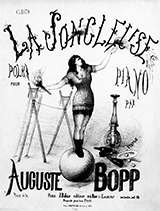by Pascal Jacob
The multi-faceted juggler is likely to insert himself into unsuspected cultural gaps or openings. When Amerindian or Chinese spotters set fires at the top of hills or towers to deliver coded messages using carefully "manipulated" smoke clouds, they improvise themselves jugglers and skilfully use the balance of the wind and the trajectories.
La Chambre des jongleurs ("Jugglers Hall") at the Torrechiara Castle near Parma was painted by Cesare Baglione between 1576 and 1585. It illustrates the diversity of acrobatic and juggling practices popular at that time, including a magnificent pyramid of jugglers capable of rotating hoops around their bodies in unexpected positions. This singular language is also magnified on the stage of many cabarets by artists on the verge of juggling and magic. La Jongleuse, a polka for piano composed by Auguste Bopp in 1878 or Le Roi des jongleurs, a very rhythmic 1958 piece by Georges Durban, integrate the figure of the artist into a popular imagery and sound. This notion is also embodied by le Bateleur, the blade of the Tarot game, sometimes represented as a juggler. A positive arcane, the Bateleur opens the major blades and symbolises a starting point or a beginning. Beyond a literal quotation, it is also a matter of questioning another relationship to virtuosity, in the search for an equilibrium point, a point of balance, either virtual or real. This notion is the basis for Chapter 17 of La Promesse de l’aube, a novel by Romain Gary published in 1960.
"In the hallways of the school, under the gaze of my dazzled comrades, I was now juggling with five or six oranges and, somewhere deep inside me, there was the mad ambition to reach the seventh and perhaps the eighth, like the great Rastelli, and even, who knows, the ninth, to finally become the greatest juggler of all time."
Despite being a virtuoso, the juggler embodies a certain form of constitutive instability and has often been the victim of a negative perception, linked to his ability to proudly exploit this fragility. The cartoon clearly highlights from one century to the next this malleability of the gesture and of its random control. The established imbalance of the characters concerned obviously finds a direct echo of their supposed political instability in humorous or... acidic performances! The cover of the illustrated supplement to the Petit Journal of the 19th of August 1893 is explicit: Georges Clemenceau, who was subjected to a fierce campaign from the opposition for the 1893 parliamentary elections, is represented as a juggler attempting to outline what he calls "Pas du commandité" (meaning "Step of the puppet") while handling heavy silver bags. The accusation was published a few days before the election that Clemenceau, despite his status as a favourite, lost by a few hundred votes compared to his rival. Another cartoon, by Izel Rosental published in 2009, shows US President Barack Obama in a very unstable balance on a rocker represented by a board perched on a globe. He juggles with daggers named Yerevan, Ankara, Iran, Iraq and Afghanistan and is concerned about the fall of the first two, placed in point-to-point balance on his forehead, which could thus compromise the fragile balance of the region and the world... A stylistic device already used at the expense of Otto von Bismarck, juggler against his will, in another 1887 American caricature entitled The European Equilibrist.
This quest for poise and perfect stability symbolically resonates in the works of the sculptor Alexandre Calder and characterises in particular his well named stabiles as it identifies certain pieces by the visual artist Richard Mac Donald. By representing Viktor Kee balancing on a bronze diamond, he combines the fluidity of the gesture with the controlled imbalance and thus transcends through the material the insolent virtuosity of the juggler. An allegorical figure, a work of art or a literary obsession, the juggler can also be found within easy reach with the set of the Grand numéro de jonglage ("Big Juggling Act") offered by the Nature et Découvertes stores, in the same way that he virtually became a star in the video game Donkey Kong Country: Tropical Freeze with the character of the loud Juggler played by a severe seal with a moustache. The game, between interpretation and a shift in meaning, is not insignificant and clearly stigmatises this integration of juggling into new cultural strata. Today, countless advertisements use the figure of a consumer juggling with a host of objects, in particular to represent the dilemma of choice.







